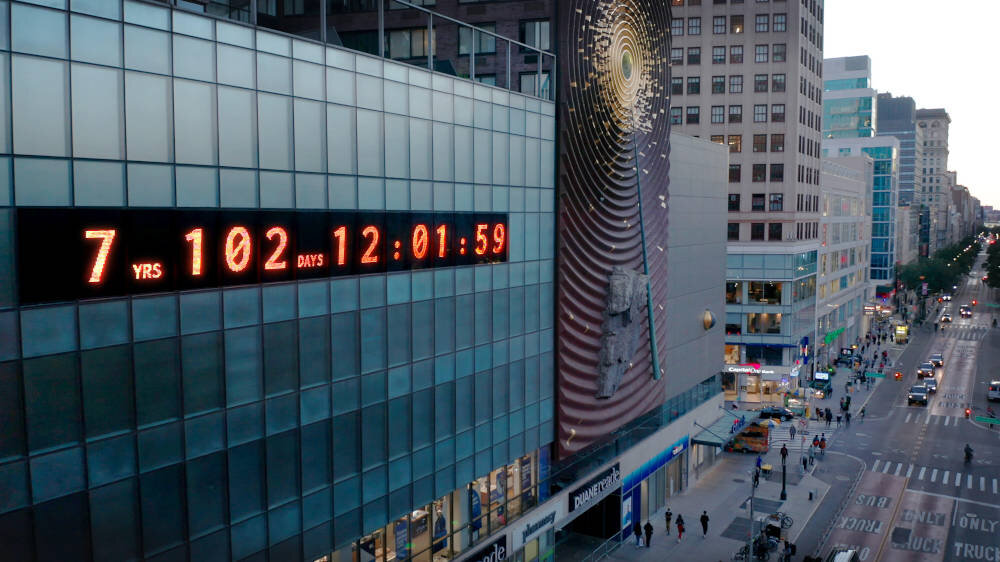
THE CLIMATE CLOCK STORY
On September 19, 2020 the Climate Clock went live.
Eighty feet across, and towering four stories above New York’s Union Square, the stark, orange-tinted letters count down the critical time window remaining for humanity to act to save itself and its only home from the ravages of climate chaos.
To stay under 1.5°C warming, and prevent the worst effects of climate change from becoming irreversible, in September 2020, the Clock told us we have an alarmingly short 7 years, 102 days, and counting to make a radical transition off of fossil fuels. It struck a nerve across the world, and quickly established itself as an iconic reference point for the urgent need for climate action.
The brainchild of climate activists Gan Golan and Andrew Boyd, art-fixer Katie Peyton Hofstadter, tech maestro Adrian Carpenter, and a clutch supporting team including leading scientists, the Mayor’s office, and a host of creatives, the Climate Clock was clearly an idea, ahem, whose time had come.
To the outside eye it may have looked like an obvious thing to do. But this was far from the first attempt by this team to launch their clock, nor was it the first climate clock.
If at first you don’t succeed…
In 2009, Deutsche Bank briefly erected a Carbon Counter billboard 70 feet above New York’s Times Square, tracking humanity’s alarming rate of carbon emissions (2 billion tons per month at the time). In 2015, musician-activist David Usher and scientist Damon Matthews began hosting an online climate clock at Concordia University’s Human Impact Lab, that in addition to carbon, tracked temperature and time. Another webpage clock, the Bloomberg Carbon Clock, has been running since 2015. In 2018, The 2° Window, an art-concept-project by Andy McWilliams and Amay Kataria went live online, and was installed in a few galleries the following year. In 2019, the Berlin Carbon Clock, a large, real-world LED-sculpture was installed by Fridays for Future and EUREF on the famous Gasometer in Berlin.

“Greta wants a Clock.”
Then, one afternoon in September 2019, we got an email: “Greta wants a clock.” Greta? That Greta? Yes, that Greta.
She wanted to hold up this clock during her speech in front of the UN General Assembly… in nine days!
But this clock was for Greta. And nobody does anything unless they’re under a deadline. Whether that’s building a weird clock. Or saving the world.
So, we put out the bat signal to our circle of creatives, and by the next evening we’d pulled together a crackerjack team of coders, makers, designers, artists and campaigners to not just make a clock for Greta but, buoyed by the attention her speech would inevitably garner, launch the full Climate Clock effort we’d originally planned.
We delivered the clock to her the night before her big speech. “Let’s do this!,” came back her smiling video message (which has since become the project’s unofficial rallying cry).
The next morning, we were all poised at our laptops ready to hit launch on the just-built website and flood the zone with #ClimateClock and #ActInTime and #TheMostImportantNumberInTheWorld hashtags as soon as Greta, clock by her side, gave her speech to the world.
UN security, however, refused to let the clock through. Oh, come on! It’s just a block with LED digits furiously counting down. Does that really look so much like a bomb?! Oh. Right. Well, that’s probably because it is a bomb! Or at least the symbol of a bomb. A slow-motion carbon time-bomb we are dropping on ourselves and all of Nature.
A monumental challenge requires… a monument.
Greta’s speech was 5-minutes long and heralded as “the climate change movement’s Gettysburg Address.” At its close, her plan had been to hand the clock to the UN Secretary General as a constant reminder of our urgent time-window for climate action. Unable to do so, she instead kept the clock with her, took it across the continent to California, then back across the Atlantic. The team regrouped. Partnered up with March for Science and Beautiful Trouble. Created a maker-kit version of Greta’s clock that anyone could build. Did a series of guerrilla light projections on the UN building timed with the COP 25 in Madrid.
But light projections are ephemeral, and Greta’s clock was small. If this was indeed “the most important number in the world,” it needed to be big, at the center of our attention, and everywhere. We needed a monument. Something visible, dramatic, and permanent. Many monuments, in fact. Big and bold enough to inspire people across the planet to “synchronize their watches” around our critical time window for climate action.
Conveniently, there already was a world-famous time-sculpture in the middle of New York City: the Metronome, in Union Square. Could we turn that into a climate clock? How do you approach another artist and ask them to, um, change their sculpture to your idea? Not to mention, get the City, the building owner, and a host of other stake-holders on board?
While Andrew and Gan worked the political angle, Katie, a curator, professor and “art-fixer,” worked her New York art world connections. She surveyed the tangled web of relationships involved and refined the proposed design, arguing for a very spare clock face, and insisting that the Clock be responsive — that it update to reflect our climate progress and do so frequently enough to give the public a palpable sense of agency. “Monuments,” she said, “tell people what we value as a culture.” Hopefully, a re-monument, would even more so.
We finally got up our courage to propose the idea to the original Metronome artists, Kristin Jones and Andrew Ginzel. The reply came back in less than 24 hours: we were thinking the same thing, they said. Wha? We met up with them a few days later and hit it off famously. Game on.
But they no longer had control of their artwork, and it took a letter of support from the Mayor and months of negotiations with the building owner to finally get into the control room of the massive sculpture. And it was only then that our real challenges began! The Metronome was running on out-of-print software and even older hardware. It was hard-wired to do one specific thing, and the company that had originally installed it had gone out of business. Trying to get it to do something else was, in the words of now project CTO Adrian, "like pushing a block of granite up a mountain.” We code-named this part of the effort Extreme Sisyphus and played Mission Impossible theme music on each visit into the innards of the clock.
Many twists and turns and late-night straining with blocks of granite later… and just in time to kick off Climate Week and mark the vernal equinox, New York’s monumental Climate Clock went live.
The response was remarkable: covered by 450 news outlets across 40 countries including the New York Time’s most popular story of the day (2.4 million reads), and the Washington Post’s most popular online post in their history (1.6 million likes), the Clock captured the public imagination.
Not just a monument, a movement…
If we thought now we could finally take a moment to relax, we couldn’t have been more wrong. As emails flooded in from all over the world, we soon realized we hadn’t just raised a monument, we’d launched a movement.
Municipal governments and civil-society teams all across the world, from Sydney to Bangkok to Istanbul, are now moving forward with plans to install climate clocks in their city-centers. A leading Italian climate scientist is championing the effort to install a climate clock in the European Parliament in Brussels to track, year-by-year, the EU’s commitment to 55% emissions reduction by 2030.
Following the step-by-step instructions in the Climate Clock maker kit, Marlvern Chimbwanda, an engineering-award-winning high-school student in Harare, Zimbabwe is assembling a clock for his school from raw components. And he’s just one of many. All over the world, hundreds of Greta-sized portable Climate Clocks are going up in schools, into the hands of climate advocates, and onto the desks of decision makers.
All these clocks are synchronized, inspiring climate stake-holders across the globe to get on the same timeline and stay on pace.
This is the Climate Decade. And this year, with the COP26 coming up in Glasgow in early November, is a do-or-die year for humanity and the planet. We must secure an ambitious and binding agreement in Glasgow… or else.
And when the country delegations arrive in Glasgow, a huge Climate Clock (located on Glasgow’s famous Science Center) will face them down. And thanks to a generous partner, there’ll also be a personal climate clock on the desk of every delegate. All synchronized, all reminding them of what the science says is necessary to stay below 1.5C warming, all demanding that they—and we—#ActInTime.
Full Circle…
From first awakenings, to being long ignored, to our spluttering attempts to gain traction, to the realization that “the fate of the world hangs in the balance and — woah! — we just created something that could help,” the story of the Climate Clock is in many ways a microcosm of the climate crisis itself. A journey from despair to emergency, the whole effort powered by a band of truth-tellers and misfits who would not give up.
The hope here, is that the same doggedness that finally got the Clock up in New York, that finally defeated the Keystone XL pipeline across Indigenous land, that finally led Greta to sit down outside the Swedish Parliament, inspiring Climate Strikes all over the world, will finally deliver the global climate Treaty — and civilization-wide mobilization — we need to transition off of fossil fuels and create a more just and sustainable society.
But even if we come up a little short in Glasgow, even if we miss the first and most important deadline that the Clock is telling us we must hit, it’ll be that same doggedness of purpose that resets the Clock and focuses us on our next most important deadline. As we say in our statement of principles, no matter what the Clock says, “we will never run out of time to act in defense of people and the planet.” Join us.


